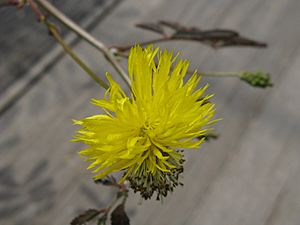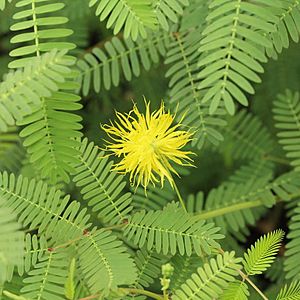Neptunia oleracea facts for kids
Quick facts for kids Neptunia oleracea |
|
|---|---|
 |
|
 |
|
| Scientific classification | |
| Genus: |
Neptunia
|
| Species: |
oleracea
|
| Synonyms | |
|
|
Neptunia oleracea, often called water mimosa or sensitive neptunia, is a special plant found in warm, tropical parts of the world. It's a type of legume, which means it belongs to the pea and bean family. This plant can even help add important nutrients like nitrogen to the soil!
The name Neptunia comes from Neptune, the Roman god of the sea. This makes sense because many plants in this group live in water. The second part of its scientific name, oleracea, is Latin for "vegetable" or "herbal." This hints at its use as a food.
Contents
About Water Mimosa
Water mimosa plants have a unique feature: they can grow special spongy, white tissue on their stems when they float in water. This tissue, called aerenchyma, helps the plant float easily. If the plant grows on land, it doesn't form this spongy tissue.
These plants usually grow about 6 inches (15 cm) tall. But their stems can spread out in the water, reaching 3 to 5 feet (0.9 to 1.5 meters) long! Their leaves look a bit like those of a mimosa plant. They are very fine and sensitive, meaning they will close up when you touch them. Each leaf has many tiny, oval-shaped leaflets arranged in pairs.
In summer, water mimosa produces small, greenish-yellow flowers. These flowers are packed closely together in round, feathery clusters. After the flowers, the plant grows flat pods that are about 1 to 2 inches (2.5 to 5 cm) long.
Sometimes, when many water mimosa plants grow together, their floating stems can form thick mats. In some tropical areas, these mats can become a problem. They can block waterways, make the water less clean, reduce fish activity, and harm other native water plants. Because of this, water mimosa is sometimes seen as an invasive weed in certain places.
Where It Lives
Water mimosa mostly grows in wet soil near the edge of water. You can also find it floating on the surface of calm water. No one is completely sure where water mimosa first came from. However, many experts believe it originated somewhere between Mexico and northern South America.
How We Use It
As Food
Water mimosa is a popular vegetable in Southeast Asia. People grow it much like they grow rice. The young stems and pods have a taste similar to cabbage. They are often eaten raw in countries like Thailand and Cambodia. You can also find them in stir-fries and curries, like the famous kaeng som.
-
Yam phak krachet, a Thai salad made with cooked water mimosa.
In Medicine
People have also used parts of the water mimosa plant for traditional medicine. For example, the juice from its stems and roots has been used for various health purposes. Scientists have studied extracts from the plant and found they might have some helpful properties for the body.
Other Names for Water Mimosa
This plant has many different names around the world:
- Khmer: Kanchait (កញ្ឆែត)
- Meiteilon/Manipuri: Eshing ekai thabi
- Thai: Phak runon (ผักรู้นอน) or phak krachet (ผักกระเฉດ)
- Vietnamese: Rau nhút
- Sinhalese: දිය නිදිකුම්බා
- Tamil language: Cuṇṭi or nīrc-cuṇṭi (These names refer to how sensitive the plant is to touch.)
- Mon: Khamək (ခမက်)
See also
 In Spanish: Sensitiva de agua para niños
In Spanish: Sensitiva de agua para niños



